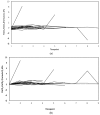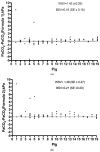Estimation of Arterial Carbon Dioxide Based on End-Tidal Gas Pressure and Oxygen Saturation
- PMID: 30235787
- PMCID: PMC6162395
- DOI: 10.3390/jcm7090290
Estimation of Arterial Carbon Dioxide Based on End-Tidal Gas Pressure and Oxygen Saturation
Abstract
Arterial blood gas (ABG) analysis is the traditional method for measuring the partial pressure of carbon dioxide. In mechanically ventilated patients a continuous noninvasive monitoring of carbon dioxide would obviously be attractive. In the current study, we present a novel formula for noninvasive estimation of arterial carbon dioxide. Eighty-one datasets were collected from 19 anesthetized and mechanically ventilated pigs. Eleven animals were mechanically ventilated without interventions. In the remaining eight pigs the partial pressure of carbon dioxide was manipulated. The new formula (Formula 1) is PaCO₂ = PETCO₂ + k(PETO₂ - PaO₂) where PaO₂ was calculated from the oxygen saturation. We tested the agreements of this novel formula and compared it to a traditional method using the baseline PaCO₂ - ETCO₂ gap added to subsequently measured, end-tidal carbon dioxide levels (Formula 2). The mean difference between PaCO₂ and calculated carbon dioxide (Formula 1) was 0.16 kPa (±SE 1.17). The mean difference between PaCO₂ and carbon dioxide with Formula 2 was 0.66 kPa (±SE 0.18). With a mixed linear model excluding cases with cardiorespiratory collapse, there was a significant difference between formulae (p < 0.001), as well as significant interaction between formulae and time (p < 0.001). In this preliminary animal study, this novel formula appears to have a reasonable agreement with PaCO₂ values measured with ABG analysis, but needs further validation in human patients.
Keywords: arterial carbon dioxide; blood gas analysis; mechanical ventilation; noninvasive measurement.
Conflict of interest statement
Authors Erkki Heinonen and Tom Häggblom are employees of GE Healthcare. Markus Skrifvars has received research funding from GE Healthcare and lecture fees from Covidien, Orion Pharma, Axis Shield Diagnostics and BARD. All other authors report no conflicts of interest.
Figures



Similar articles
-
Evaluating a novel formula for noninvasive estimation of arterial carbon dioxide during post-resuscitation care.Acta Anaesthesiol Scand. 2020 Oct;64(9):1287-1294. doi: 10.1111/aas.13652. Epub 2020 Jul 8. Acta Anaesthesiol Scand. 2020. PMID: 32521045
-
End-inspiratory rebreathing reduces the end-tidal to arterial PCO2 gradient in mechanically ventilated pigs.Intensive Care Med. 2011 Sep;37(9):1543-50. doi: 10.1007/s00134-011-2260-y. Epub 2011 Jun 7. Intensive Care Med. 2011. PMID: 21647718
-
Agreement between arterial partial pressure of carbon dioxide and saturation of hemoglobin with oxygen values obtained by direct arterial blood measurements versus noninvasive methods in conscious healthy and ill foals.J Am Vet Med Assoc. 2011 Nov 15;239(10):1341-7. doi: 10.2460/javma.239.10.1341. J Am Vet Med Assoc. 2011. PMID: 22044332
-
Relationship between arterial and end-tidal carbon dioxide pressures during anesthesia using a laryngeal tube.Acta Anaesthesiol Scand. 2005 Jul;49(6):759-62. doi: 10.1111/j.1399-6576.2005.00698.x. Acta Anaesthesiol Scand. 2005. PMID: 15954955 Clinical Trial.
-
Estimating Arterial Partial Pressure of Carbon Dioxide in Ventilated Patients: How Valid Are Surrogate Measures?Ann Am Thorac Soc. 2017 Jun;14(6):1005-1014. doi: 10.1513/AnnalsATS.201701-034FR. Ann Am Thorac Soc. 2017. PMID: 28570147 Review.
Cited by
-
Enhancing the estimation of PaCO2 from etCO2 during ventilation through non-invasive parameters in the ovine model.Biomed Eng Online. 2024 Oct 24;23(1):104. doi: 10.1186/s12938-024-01292-2. Biomed Eng Online. 2024. PMID: 39449028 Free PMC article.
-
The PaCO2-ETCO2 gradient in pre-hospital intubations of all aetiologies from a single UK helicopter emergency medicine service 2015-2018.J Intensive Care Soc. 2022 Feb;23(1):11-19. doi: 10.1177/1751143720970356. Epub 2020 Oct 29. J Intensive Care Soc. 2022. PMID: 37593537 Free PMC article.
-
Post-COVID breathlessness: a mathematical model of respiratory processing in the brain.Eur Arch Psychiatry Clin Neurosci. 2024 Dec;274(8):1857-1868. doi: 10.1007/s00406-023-01739-y. Epub 2024 Mar 19. Eur Arch Psychiatry Clin Neurosci. 2024. PMID: 38502207 Free PMC article.
-
Increased breathlessness in post-COVID syndrome despite normal breathing patterns in a rebreathing challenge.Sci Rep. 2025 Jul 29;15(1):27666. doi: 10.1038/s41598-025-11728-x. Sci Rep. 2025. PMID: 40730844 Free PMC article.
References
LinkOut - more resources
Full Text Sources
Other Literature Sources
Miscellaneous

